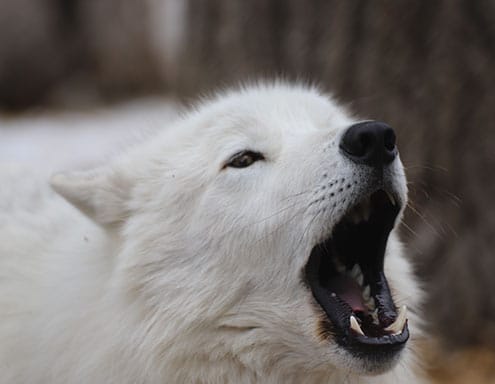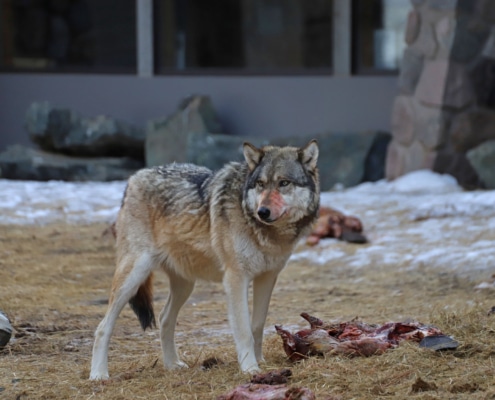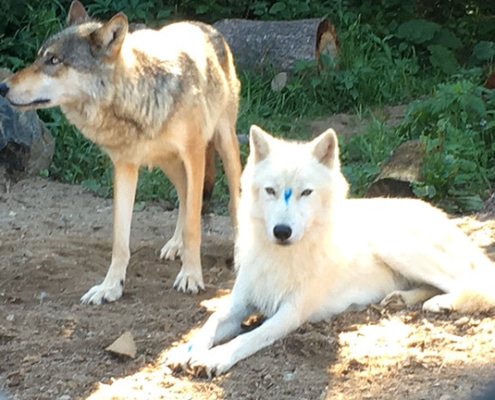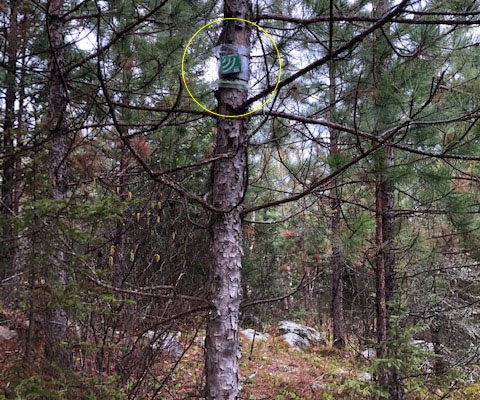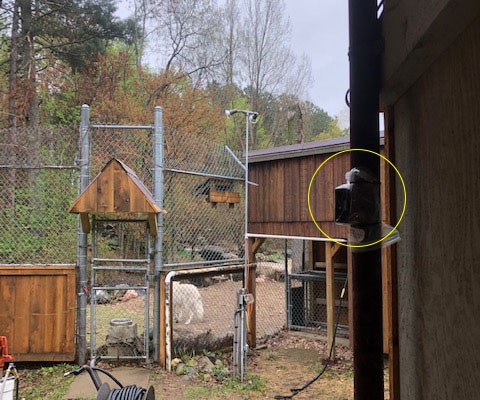Ambassador Wolves Participate in Research Studies
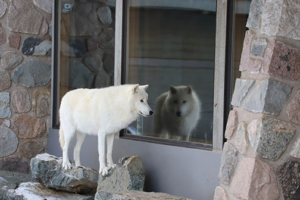 By Shannon Barber-Meyer, Lori Schmidt, Vicente Palacios and Barbara Marti-Domken’
By Shannon Barber-Meyer, Lori Schmidt, Vicente Palacios and Barbara Marti-Domken’
The International Wolf Center wolves are famous for providing unique educational opportunities to visitors in Ely and to people online around the globe. Less known are the contributions these wolves make to scientific research. Recently the Center’s Exhibit Pack and Retired Pack were subjects of behavioral and acoustic research projects.
Self-Recognition— The Wolf in the Mirror
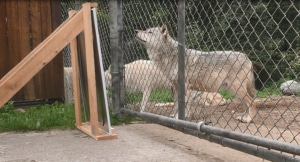
Aidan sniffs the mirror during the sham mark test.
The idea for this behavioral research was hatched in 2017 as Shannon Barber- Meyer read a 2011 book by Diana Reiss that described assessing dolphin self-awareness via the mirror self-recognition (MSR) test. The majority of animals that convincingly pass the test are highly social mammals whose wild counterparts live in complex societies.
Searching for information about wolves and the MSR test, Barber-Meyer found one mention: Marc Bekoff wrote in 2014 that this highly social species did not pass the test—but there were no additional details about study design or results. Given the many possible reasons for failure (differences between individual wolves, study design, rearing conditions, etc.), Barber-Meyer was interested in reexamining wolves. She took the idea to Lori Schmidt, wolf curator at the International Wolf Center, and found her eager to obtain information useful to captive management, such as insight into wolves’ perceptions of their reflections that might affect their psychological state and, therefore, pack dynamics. Thus, Barber-Meyer and Schmidt set out to test the Center Exhibit and Retired Packs during summer 2017.
The MSR test was developed by Dr. Gordon Gallup, Jr. who conducted a series of experiments with chimpanzees. Results, published in 1970, revealed that chimpanzees apparently recognized themselves in a mirror. The experiment consisted of marking the chimpanzees on their heads where they could not see the mark without the use of a mirror. After prolonged exposure to a mirror, the chimpanzees touched the mark on their heads when looking at their reflection, implying that they understood they were looking at themselves.
There is debate about what it means to pass the MSR test. The spectrum of self-awareness ranges from demonstrating that the animal possesses empathy to merely that the animal can solve problems or is stimulated by an interesting visual experience. Expanding on the pass-fail paradigm, J.M. Plotnik and others in 2006 described four progressive stages in the MSR test, including social response to the mirror, physical mirror inspection, repetitive mirror-testing and self-directed behaviors in front of the mirror. The research group followed this categorization when analyzing the Center wolves’ behaviors during the MSR test in order to demonstrate partial successes and highlight stages where wolves struggled.
Typical MSR tests include an invisible “sham-mark” test and a visible-mark test. The visible mark is applied in a place where the subject is unable to see it unless using the mirror. The sham-mark is applied following the same procedure as when applying the visible mark, but no visible mark is left. (In this case, the cap was left on the marking device.) Comparisons between self-directed behaviors in each test are used to conclude whether the animal exhibited self-recognition. The researchers used a mirror in which wolves could view their entire bodies, and they recorded each wolf’s behavioral response to the mirror for 10 minutes when sham-marked and also with a highly visible mark on its forehead. Boltz, then a 5-year-old male in the exhibit pack, was not interested in participating in the visible-mark part of the study, so the other wolves—Grizzer, Aidan, Denali, Grayson and Axel— were marked with blue, waxy “chalk.” The black-coated Luna was marked with yellow.
The wolves showed no social response to the mirror. They did some mirror inspecting and some possible repetitive mirror testing. They exhibited no self-directed behaviors (e.g., examining parts of their bodies they otherwise would never see.) Subsequently they all rapidly lost interest in the mirror and were not interested in their marks— even the ones applied to their own feet.
Domestic dog puppies less than 4 months old reportedly show a social response to their reflection (Zazzo, 1979) that older dogs don’t. Researchers suspect none of the wolves showed a social response because they may have developed beyond that phase—and that they rapidly lost interest in the mirror because they are accustomed to their partial reflections in the Center windows. They may have been uninterested in their marks because they are often naturally marked on their muzzles and elsewhere after feeding. Determining what constitutes an interesting mark for a wolf remains a challenge.
Although the Center wolves did not pass this MSR test by showing self-awareness with the mark, observations of wild wolves hunting with flexible and complex strategies suggests that wolves do possess self-awareness. Olfaction and auditory tests are other interesting possibilities for examining wolf self-awareness. Barber-Meyer and Schmidt suspect that evidence from several methods of inquiry will reveal the level of wolf self-awareness better than any single test.
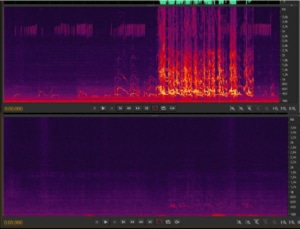
The top spectrogram depicts a chorus howl recorded by the Center unit. The bottom spectrogram is of the same howl, but at the remote device 1.6 km (1 mi) away. The vocal event is still visible, but it is considerably dampened. Images courtesy of Vicente Palacios. Generated in Adobe Audition CSG, Adobe Systems.
Eavesdropping on Wolves
In 2019, Barber-Meyer and Schmidt began collaboration on another Center research project—an acoustic study in Spain with wolf vocalization experts Dr. Vicente Palacios and Barbara Marti-Domken. Palacios had recorded chorus howls (audio and video) by the Center’s ambassador wolves when he visited in 2007 and 2008. These recordings contributed to Palacios’ Ph.D. research and Marti-Domken’s master’s thesis. Building on this foundation of acoustic research with the ambassador wolves, the authors were interested in assessing a new, passive acoustic recording device called the AudioMoth. The small, easily portable and inexpensive (about $80 USD) device had been successful in detecting bats and gun shots related to poaching but had never been used to research wolves. The four collaborating researchers wanted to use it to monitor wild wolf packs via their howls—but first they needed to know how well it worked under ideal and less-ideal conditions. They designed a test with the ambassador wolves at center stage.
During summer 2019, they deployed one unit at the Center to compare that unit’s recordings with real-time howling data documented by on-site staff and volunteers. To determine how well AudioMoths performed at distance, they set up a remote array in generally an ESE direction from the Center with a unit stationed about every ½ km (1/3 mi) out to 3.2 km (2 mi) in the surrounding Superior National Forest from May 22 to June 17.
From audio files collected by the Center unit, the authors grouped more than 1,500 vocalizations into 428 vocal events (236 solo howl series and 192 chorus howls). The Center unit was perfect in detecting chorus and solo howls, according to what on-site staff documented. The remote array detected 50% of choruses and 12% of solo howls. With respect to detection distance, chorus howls were detected by the farthest unit at 3.2 km (2 mi) at a rate of 9%, whereas solos were detected at that same rate at just 1/3 mi. Calm or favorable wind that carried the vocalization to the devices increased detection distance and detectability. For information on other variables tested, refer to the publication (Barber-Meyer et al., 2020).
The researchers encountered challenges such as limited detection range, which may be improved using a parabolic dish (currently being tested by others)—but that could affect directionality. Battery life (14 days if run 24 hours a day) can be extended by attaching an external battery—but that would affect the ease of multiple, remote deployments. Problems with environmental noise occurred at a detector too close to a gravel road, resulting in some missed vocalizations that a more distant detector captured. Although it was not a specific objective, the study confirmed that wild pups can be detected using AudioMoths; their higher-pitched howls were recorded by the farthest unit.
Based on the study results, the researchers determined that AudioMoths are probably most useful in monitoring specific sites where wild wolves don’t move much, such as spring and early-summer homesites. They can be used to measure howling rate and also to confirm reproduction by the presence of pup howls. They might be useful during winter to monitor wolves at large kill sites—if the wolves reliably return. They could also be used in occupancy surveys in combination with camera traps. Eventually, they may be useful in determining the number of wolves in a pack.
The authors also deployed these devices in the wild around summer homesites of wolves as part of a separate National Geographic-funded project in cooperation with researchers from Spain, India and Yellowstone National Park. They encountered problems in the Superior National Forest in Minnesota, where sled dog vocalizations overwhelmed the recordings of wolves howling. They also found it challenging to keep the detectors close enough to wolves when they moved, mainly due to reliance on duty-cycled (off for 12 hours a day) VHF radio collars, howl surveys, and delayed Global Positioning System (GPS) locations sent from GPS collars to monitor wolf movements. GPS collars on breeding females, with location information sent frequently to researchers, would be ideal for helping to keep the devices within detection range. They plan to continue this research during summer 2021.
During winter 2020, the research group recorded for comparison the breeding-season howl rates of the Center wolves and those at a wolf center in Spain. Results from both the wild-wolf summer research and the captive-wolf winter research are pending. The authors thank the Center staff, Center volunteers and the USGS volunteers who collected data, along with National Geographic, the International Wolf Center and the USGS for funding and support.
Stay tuned as the ambassador wolves continue to educate the world about wolves and contribute to scientific research that provides information about their wild relatives. The authors thank Erin Stahler and Madeline Jackson (Yellowstone National Park) for reviewing an earlier draft of this article. Any mention of trade, product or firm names is for descriptive purposes only and does not imply endorsement by the U.S. Government.
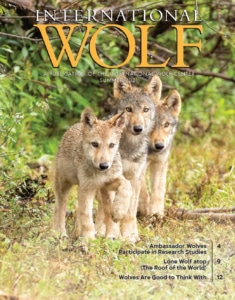 This article was originally published in the Summer 2021 edition of International Wolf magazine, which is published quarterly by the International Wolf Center. The magazine is mailed exclusively to members of the Center.
This article was originally published in the Summer 2021 edition of International Wolf magazine, which is published quarterly by the International Wolf Center. The magazine is mailed exclusively to members of the Center.
To learn more about membership, click here.
Tracy O’Connell is a professor emeritus of marketing communications at the University of Wisconsin-River Falls and serves on the Center’s communications and magazine committees.

